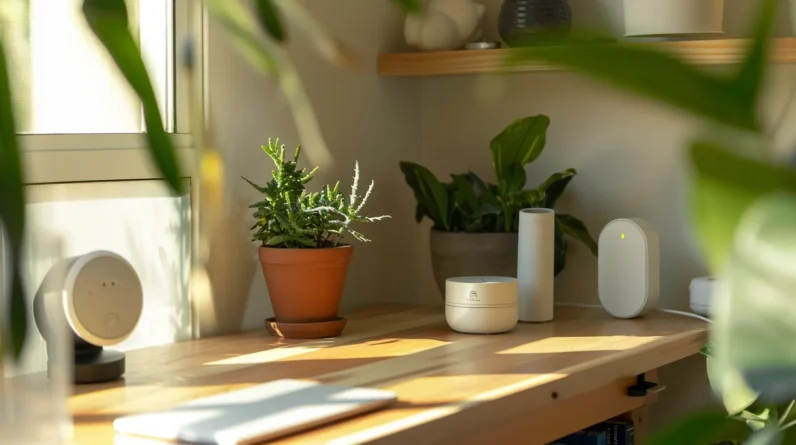
We need to prioritize smart gadget security to prevent unauthorized access and data breaches. We should start by changing default passwords to strong, unique ones and customizing settings to our needs. Regularly updating firmware and software is also essential to address newly discovered vulnerabilities. Implementing strong authentication methods like multi-factor authentication and using password managers can prevent unauthorized access. Moreover, we should use secure networks and connections, limit access and privileges, and regularly monitor device activity. By following these best practices, we can minimize the risk of cyber threats – and there’s more we can do to safeguard our smart gadgets.
Secure Default Passwords and Settings
We need to acknowledge that default passwords and settings on our smart gadgets are a security threat waiting to happen, as they provide an open door for hackers and cybercriminals to exploit. It’s important we take immediate action to secure them. We must change default passwords to strong, unique ones, and avoid using easily guessable information. We should also review and customize settings to our needs, disabling any unnecessary features or services. Moreover, we must guarantee we’re using secure communication protocols, such as HTTPS, to encrypt our data. By taking these steps, we can greatly reduce the risk of our smart gadgets being compromised. We can’t afford to be complacent; it’s our responsibility to safeguard our devices and data.
Regularly Update Firmware and Software
By securing our smart gadgets’ default settings, we’ve taken an important step towards safeguarding our devices, but it’s equally important to regularly update firmware and software to make sure we’re protected from newly discovered vulnerabilities. We can’t assume that our gadgets are secure just because we’ve changed the default passwords. New threats emerge constantly, and manufacturers release updates to address them. It’s essential that we install these updates as soon as they’re available. We should enable automatic updates whenever possible and regularly check for updates manually. This ensures we’ve got the latest security patches and features. By staying on top of firmware and software updates, we greatly reduce the risk of our gadgets being exploited by cybercriminals.
Implement Strong Authentication Methods
As cybercriminals continually devise new methods to crack passwords, it’s essential that we implement strong authentication methods to safeguard our smart gadgets. We must go beyond simple passwords and employ multi-factor authentication (MFA) that combines something we are familiar with (passwords) with something we possess (smart cards or tokens) or something we are (biometric data). This layered approach guarantees that even if one method is compromised, others will prevent unauthorized access. We should also use password managers to generate and store unique, complex passwords for each device. By implementing these robust authentication methods, we greatly reduce the risk of unauthorized access to our smart gadgets and the sensitive data they store.
Use Secure Networks and Connections
When we’re on the go, our smart gadgets often rely on public Wi-Fi networks or mobile hotspots to stay connected, but these networks can be vulnerable to eavesdropping and man-in-the-middle attacks. To mitigate these risks, we use virtual private networks (VPNs) to encrypt our internet traffic. We also avoid using public computers or public Wi-Fi to access sensitive information, as these can be compromised by malware or keyloggers. Instead, we rely on our own mobile hotspots or secure Wi-Fi networks. Moreover, we make sure our gadgets are configured to ask for permission before connecting to a new network, and we regularly review our device’s list of trusted networks to remove any suspicious or unknown connections. By taking these precautions, we can significantly reduce the risk of our gadgets being compromised.
Limit Access and Privileges
We guarantee access to our smart gadgets and sensitive information by implementing a principle of least privilege, where each user and process is granted only the minimum level of access and privileges necessary to perform their tasks. This limits the attack surface and prevents lateral movement in case of a breach. We also incorporate role-based access control, ensuring that each user has a unique set of privileges tailored to their job function. Moreover, we regularly review and update access privileges to ensure they align with changing job responsibilities. By limiting access and privileges, we reduce the risk of insider threats and minimize the damage that can be done in the event of a security incident.
Monitor Device Activity and Logs
By monitoring device activity and logs, we can quickly identify potential security breaches and respond promptly to minimize their impact. This proactive approach enables us to detect anomalies, unusual patterns, and suspicious behavior that may indicate a security threat. We should regularly review device logs to identify potential vulnerabilities and address them before they’re exploited. This includes monitoring system logs, network traffic, and application logs. By doing so, we can identify unauthorized access, data breaches, and other security incidents. We should also set up alerts and notifications for abnormal activity, ensuring we’re informed promptly of any potential security issues. By staying vigilant, we can respond quickly to potential breaches and prevent significant damage.
Disable Unused Features and Services
Many smart gadgets and devices come with a plethora of features and services enabled by default, leaving them vulnerable to exploitation by hackers. We need to take control of our devices’ security by disabling any unused features and services. This reduces the attack surface, minimizing the risk of exploitation. We should regularly review our device settings to identify unnecessary features and services, and disable them promptly. For instance, if we don’t use Bluetooth, we should disable it to prevent potential Bluetooth-based attacks. Similarly, if we don’t use a particular app or feature, we should uninstall or disable it to prevent potential vulnerabilities. By doing so, we can greatly diminish the risk of our devices being compromised by hackers.
Perform Regular Security Audits
Conducting regular security audits helps identify vulnerabilities and guarantees our devices are fortified against emerging threats. We can’t assume our gadgets are secure just because we’ve implemented robust security measures. Audits help us stay proactive, detecting potential weaknesses before they’re exploited. We should scrutinize our devices, networks, and systems, evaluating their configurations, patch levels, and access controls. By doing so, we can identify and remediate vulnerabilities, ensuring our smart gadgets are resilient to attacks. Regular audits also help us stay compliant with evolving security standards and regulations. By making auditing a habit, we can greatly reduce the risk of breaches and data compromise, ultimately safeguarding our digital lives.
Conclusion
As we wrap up our journey through the world of smart gadget security, one thing is clear: the battle for digital supremacy is far from over. New threats lurk around every corner, waiting to pounce on unsuspecting victims. But we’re not victims – we’re vigilantes, armed with the knowledge and best practices to stay one step ahead of the cyber-criminals. So, stay vigilant, stay safe, and remember: in the world of smart gadget security, complacency is a luxury we can’t afford.







